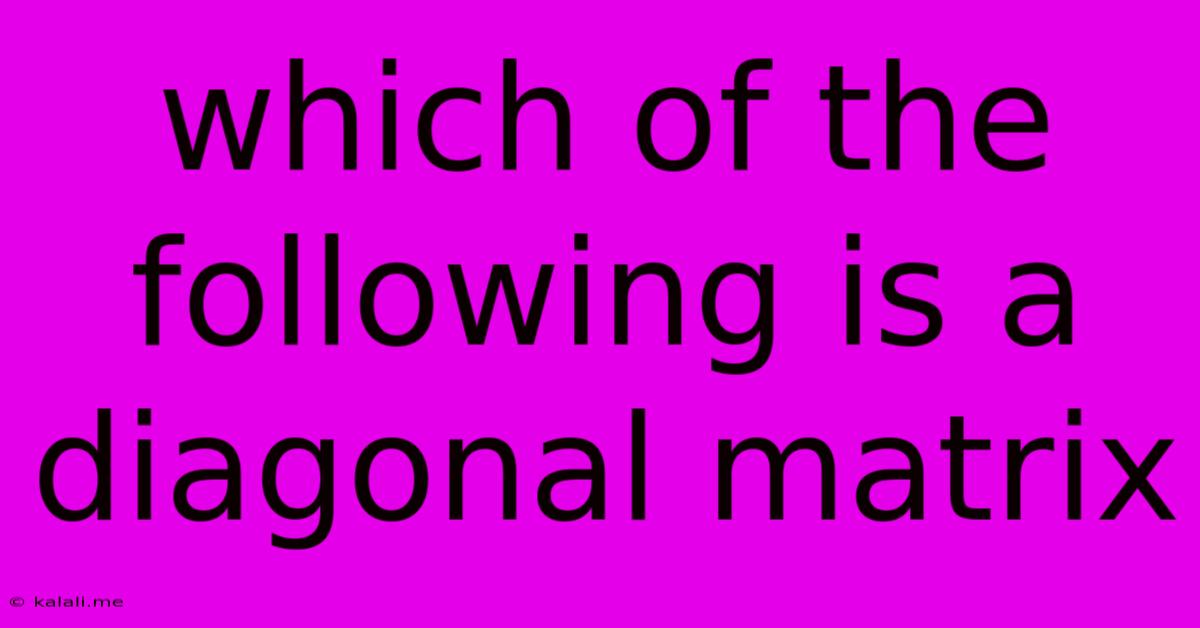Which Of The Following Is A Diagonal Matrix
Kalali
Jun 14, 2025 · 3 min read

Table of Contents
Which of the Following is a Diagonal Matrix? A Comprehensive Guide
Understanding diagonal matrices is crucial in linear algebra and various applications. This article will define diagonal matrices, explain their properties, and guide you through identifying them from a given set of matrices. We'll also touch upon their importance in fields like computer graphics and data analysis. This guide will equip you with the knowledge to confidently determine whether a matrix fits the definition of a diagonal matrix.
A diagonal matrix is a special type of square matrix where all the elements outside the main diagonal are zero. The main diagonal runs from the top-left to the bottom-right corner. Let's break this down further.
Defining Characteristics of a Diagonal Matrix
- Square Matrix: A diagonal matrix must first be a square matrix, meaning it has the same number of rows and columns.
- Zero Off-Diagonal Elements: All elements not on the main diagonal must be equal to zero. These are the elements located above and below the main diagonal.
- Main Diagonal Elements: The elements on the main diagonal can be any real or complex number, including zero.
Examples of Diagonal Matrices
Consider these examples:
[[2, 0, 0], [0, 5, 0], [0, 0, -1]]This is a diagonal matrix.[[1, 0], [0, 1]]This is a diagonal matrix – in fact, it's the identity matrix (a special case of a diagonal matrix).[[0, 0, 0], [0, 0, 0], [0, 0, 0]]This is also a diagonal matrix (a zero matrix).
Examples of Matrices that are NOT Diagonal Matrices
Here are some examples of matrices that do not meet the criteria for a diagonal matrix:
[[1, 2, 3], [4, 5, 6], [7, 8, 9]]This is not a diagonal matrix because it has non-zero elements off the main diagonal.[[1, 0], [1, 1]]This is not a diagonal matrix because it has a non-zero element below the main diagonal.[[1, 2], [3, 4]]This is not a diagonal matrix because it has non-zero elements off the main diagonal and it's not a square matrix.
Identifying Diagonal Matrices: A Step-by-Step Approach
To determine whether a given matrix is a diagonal matrix, follow these steps:
- Check for Square Shape: Verify that the matrix has the same number of rows and columns. If not, it cannot be a diagonal matrix.
- Examine Off-Diagonal Elements: Inspect all elements not on the main diagonal. If any of these elements are non-zero, the matrix is not a diagonal matrix.
- Main Diagonal Elements: The elements on the main diagonal can be any value; this step doesn't disqualify a matrix from being diagonal.
Applications of Diagonal Matrices
Diagonal matrices are incredibly useful in various mathematical and computational contexts:
- Linear Algebra: They simplify matrix multiplication and eigenvalue calculations.
- Computer Graphics: They are used in transformations like scaling and shearing.
- Data Analysis: They are employed in covariance matrices and other statistical computations.
By understanding the fundamental characteristics of diagonal matrices and applying the steps outlined above, you can accurately identify them from a collection of matrices. Remember, the key is a square shape and the absence of non-zero elements off the main diagonal.
Latest Posts
Latest Posts
-
What Are The Factors For 62
Jun 14, 2025
-
Si Unit For Density Of Water
Jun 14, 2025
-
Which Of These Volcanic Eruption Types Is The Most Violent
Jun 14, 2025
-
Which Bone Is Not In The Middle Ear
Jun 14, 2025
-
What Is The Largest Cell In The Body
Jun 14, 2025
Related Post
Thank you for visiting our website which covers about Which Of The Following Is A Diagonal Matrix . We hope the information provided has been useful to you. Feel free to contact us if you have any questions or need further assistance. See you next time and don't miss to bookmark.